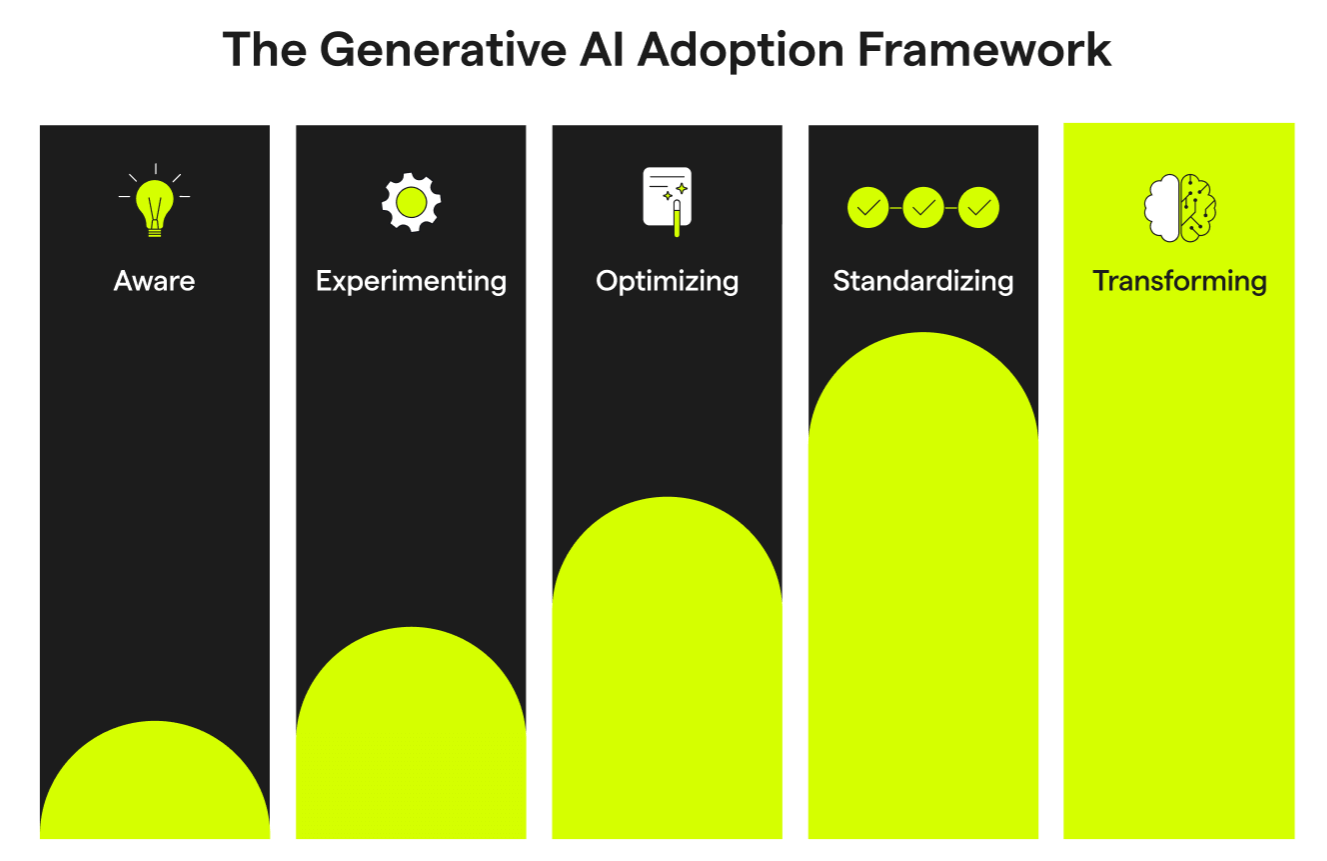Over the past year, artificial intelligence (AI) has been dominating headlines in business, technology, and academics (to name a few). Of course, it’s mainly generative artificial intelligence (gen AI) that people are talking about when they refer to the latest AI tools. But it’s important to break through the buzzy headlines to understand the massive opportunity that this transformative technology presents.
Business communication is one of the biggest areas for disruption. In the US alone, gen AI has the potential to save up to $1.6 trillion annually in productivity if all workers were using it for communication. However, every organization is in a different stage of generative AI adoption. Some companies are avoiding the new technology, resisting change from their traditional working methods. Many have a piecemeal approach to generative AI adoption, experimenting with different tools across a few select teams. And few, if any, have reached enterprise-wide adoption, using gen AI to its maximum potential to transform their business.
In this blog, we’re covering the five phases of generative AI adoption in business—and uncovering the gaps that might be preventing you from reaching the next level.
The Generative AI Adoption Framework
Gen AI has quickly emerged as a key driver and accelerator in business transformation. Whether you’re using it to gain new insights, increase content production, automate tedious and manual work, or enhance overall communication quality, it’s likely that your business and employees have seen some of the benefits of this new technology.
However, as generative AI technologies continue to evolve, it can be challenging to keep up and understand how to most effectively leverage these tools. This is where the generative AI adoption framework comes in. Use this as a way to assess where your organization is currently, identify areas for improvement, and navigate the complex landscape of gen AI so you can transform your business.
The 5 Stages of Generative AI Adoption

- Aware. The first stage is simply being aware of generative AI technology. At this stage, people within your organization have an early interest in gen AI and may be researching different tools to build an understanding of their capabilities and different use cases for your business. It’s likely that no one is using gen AI tools yet. Instead, the focus is on garnering interest in gen AI, exploring its potential for business communication, and finding out how to use it to add value for employees.
- Experimenting. The second stage is all about experimentation with gen AI tools. In this phase of adoption, AI literacy is likely limited, with only a few select people or teams actively using gen AI in their day-to-day work. In the experimentation stage, there is no formal gen AI strategy in place and it’s likely that each team within your organization is experimenting with a different tool. The focus here is on exploring the potential of AI, building skills and expertise to improve communication, and identifying areas where gen AI is adding value to the business.
- Optimizing. In the third stage of generative AI adoption, businesses are focused on optimization. Graduating from the experimentation phase means applying all of the lessons learned into repeatable processes. You should use that to define a gen AI strategy and implement tools for the majority of your employees to use regularly. In this stage, it’s important to improve the AI literacy of your entire workforce, not just certain individuals or teams. Gen AI should become integrated into key business processes, and your focus here should be on achieving measurable improvements in productivity, communication effectiveness, and business performance.
- Standardizing. The fourth stage is all about ensuring standardized usage of gen AI across the business. This involves investing in proper technology for every team, creating a culture of innovation, and encouraging appropriate use of gen AI tools to drive the business forward. In this stage, gen AI is integrated into every area where employees communicate. The focus here is on empowering every employee to communicate with more effectiveness, clarity, and context rather than more noise. At this stage, you’re driving maximum efficiency across teams, scaling automation and content creation, and creating a competitive advantage due to gains in productivity and creativity.
- Transforming. The final stage of enterprise-wide gen AI adoption is when businesses truly transform and gain a competitive edge. At this level, your business is using gen AI to completely transform its operations and employees’ communication. Your business is likely seen as a leader in your industry, recognized for driving innovation and disruption. The focus here is on maximizing the benefits you see in employee productivity, business communication, customer satisfaction, and the bottom line.
Understanding where your business is in its gen AI adoption journey is key if you want to adapt and win in today’s competitive market. This framework should help you understand your current stage of adoption, but how do you know what’s holding you back from reaching the next stage?
Gen AI Adoption Gaps: What’s Holding You Back From Reaching the Next Stage
Having an understanding of where your business currently sits is a solid first step toward business transformation. But it’s what you do with that knowledge that really matters. Enter generative AI adoption gaps. These are the key blockers that companies must overcome to reach enterprise-wide AI adoption:
Stage: Aware
- The zero-to-one gap. If your business is stuck in the awareness stage, it’s likely that you have a lack of buy-in across the organization to try out gen AI technology. You could be missing key buy-in from leadership, whose approval you need before bringing in new technology. It could also be because the company is stuck in a state of fear of messing up, so they’re avoiding getting started altogether. Or there could be a lack of buy-in from employees who prefer to avoid new technology and use more traditional methods to communicate.
- How to bridge the gap: To enter the next phase of experimentation, you should focus on communicating the benefits of generative AI for individuals and the business so that both employees and leadership are keen to try it out. Start small and simple. You don’t need your long-term AI strategy fully developed from the get. Choose one problem, like improving one team’s communication effectiveness, and see how gen AI can solve it.
Stage: Experimenting
- The literacy gap. The majority of companies today are in the experimentation stage of gen AI adoption. It’s possible that you have a few individuals who use gen AI regularly for communication, but your workforce’s overall AI literacy is holding you back from reaching the next phase. Someone who is literate with gen AI has a fundamental understanding of the tools and their capabilities, is comfortable using them regularly for some communication tasks, and is starting to see personal benefits—but has room to improve to realize its full potential.
- How to bridge the gap: The key to bridging this gap and entering the next stage of optimization is investing in proper training and policies. It’s crucial to ensure that your entire workforce not only feels confident using gen AI for their roles’ specific use cases but also knows your organization’s guidelines and policies around gen AI usage to enhance business communication.
Stage: Optimizing
- The technology gap. Once your workforce has elevated its AI literacy and is well on its way to becoming fluent, it’s time to turn your attention to the technology you invest in. If you find your business stuck in the optimization phase, it’s likely because you don’t have the proper AI communication tools in place to support each function or the strategies to make the most of those tools.
- How to bridge the gap: To enter the next stage of standardization, it’s crucial to invest in trusted, responsible, and ubiquitous generative AI technology. Not all generative AI tools are created equal. For your entire workforce to reap the benefits, you’ll need a solution that combines user-friendliness, scalability, and robust data security. The best place to start is an AI-powered communication assistant that is easily embedded into employees’ existing workflows and communication channels.
Stage: Standardizing
- The systems gap. The final gap that you must overcome to achieve gen AI-powered business transformation is building systems that standardize AI usage and effective communication throughout your enterprise. You must ensure that everyone is invested in a culture of innovation. When you focus on building systems that support this culture, you’ll upskill your entire workforce, enable everyone to communicate more effectively, and maximize the benefits of generative AI.
- How to bridge the gap: To bridge the systems gap and achieve business transformation, you’ll need to double down on standardization. This means standardizing the tools you invested in (from the technology gap above) and creating standardized, role-specific training and enablement so every employee feels confident in using them effectively.
Unlocking the Potential of Generative AI
As gen AI continues to demonstrate its transformational capabilities on business communication for organizations across all industries, it’s critical for you to take this moment to assess where your business stands. Once you know what stage you’re in, you can prioritize building a strategy for gen AI adoption. In the next chapter, we’ll lay out a roadmap to get started or improve your gen AI capabilities to scale effective communication, drive business results, and stay ahead of the competition.
Ready to find out what stage your business is in? Take this assessment to get started.



